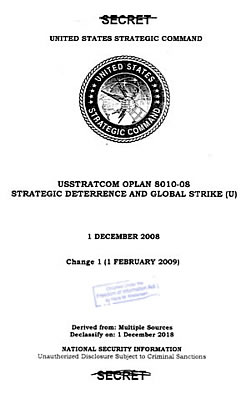Rewriting US Presidential Nuclear War Planning Guidance
 |
| How will Obama reduce the role of nuclear weapons in the strategic war plan? |
.
By Hans M. Kristensen
The Obama administration has begun a review of the president’s guidance to the military for how they should plan for the use of nuclear weapons. The review, which was first described in public by National Security Advisor Tom Donilon, is the ultimate test of President Obama’s nuclear policy; the rest is just words: to what extent will the new guidance reduce the role of nuclear weapons in the war plan?
Although the administration’s Nuclear Posture Review is widely said to reduce the role of nuclear weapons, it doesn’t actually reduce the role that nuclear weapons have today because all the adversaries in the current strategic nuclear war plan are exempt from the reduction. They are either nuclear weapon states, not members of the nuclear Non-Proliferation Treaty, or are in violation of their NPT obligations and have chemical or biological weapons. The new guidance would have to remove some of these adversaries from the war plan to reduce the role, or reduce the role that nuclear weapons are required to play against each of them. There are many ways this could be done:
- Reduce the numer of target categories that are held at risk with nuclear weapons.
- Reduce the damage expectancy to be a achieved against individual targets.
- Reduce the number of adversaries in the plan.
- Reduce the number and types of strike options against each adversary.
- Remove the requirement to plan for prompt launch of nuclear forces.
- Remove any requirement to plan for damage limitation strikes.
- End counterforce nuclear planning.
- End the requirement to maintain standing fully operational strike plans.
Reducing the role of nuclear weapons in the war plan requires direct and continuous presidential attention to avoid that the commitments to reducing the number and role of nuclear weapons are watered down by bureaucrats and cold warriors in the National Security Council, Department of Defense, military commands and Services, as well as former officials who are busy lobbying against a reduction.
To support president Obama’s vision of dramatically reduced nuclear arsenals and a reduced role of nuclear weapons on the way to deep cuts of nuclear weapons and eventually disarmament, we published a study in 2009 that proposed a transition from counterforce planning to what we called a minimal deterrent. A study from 2010 further described the current strategic nuclear war plan (OPLAN 8010-08 Change 1 from February 1, 2009 – this plan is still in effect). Building on those two studies, we have a new op-ed in the Bulletin of the Atomic Scientists that describes what a new presidential directive could look like: A Presidential Policy Directive for a new nuclear path.
This publication was made possible by a grant from Carnegie Corporation of New York and Ploughshares Fund. The statements made and views expressed are solely the responsibility of the author.
While it is reasonable for governments to keep the most sensitive aspects of nuclear policies secret, the rights of their citizens to have access to general knowledge about these issues is equally valid so they may know about the consequences to themselves and their country.
Nearly one year after the Pentagon certified the Sentinel intercontinental ballistic missile program to continue after it incurred critical cost and schedule overruns, the new nuclear missile could once again be in trouble.
“The era of reductions in the number of nuclear weapons in the world, which had lasted since the end of the cold war, is coming to an end”
Without information, without factual information, you can’t act. You can’t relate to the world you live in. And so it’s super important for us to be able to monitor what’s happening around the world, analyze the material, and translate it into something that different audiences can understand.